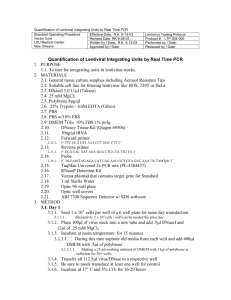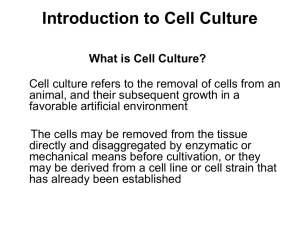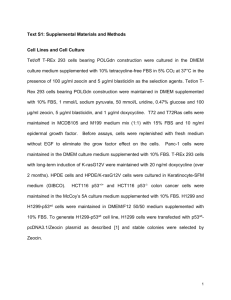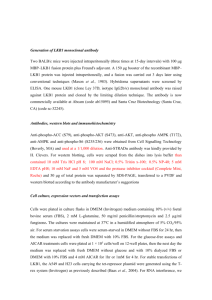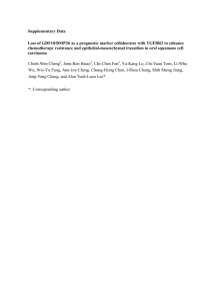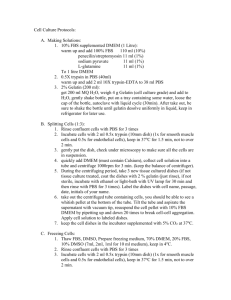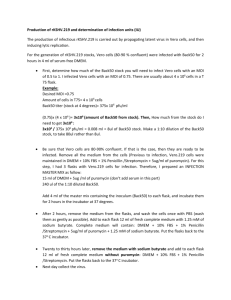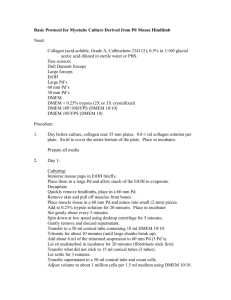Culture Media
advertisement
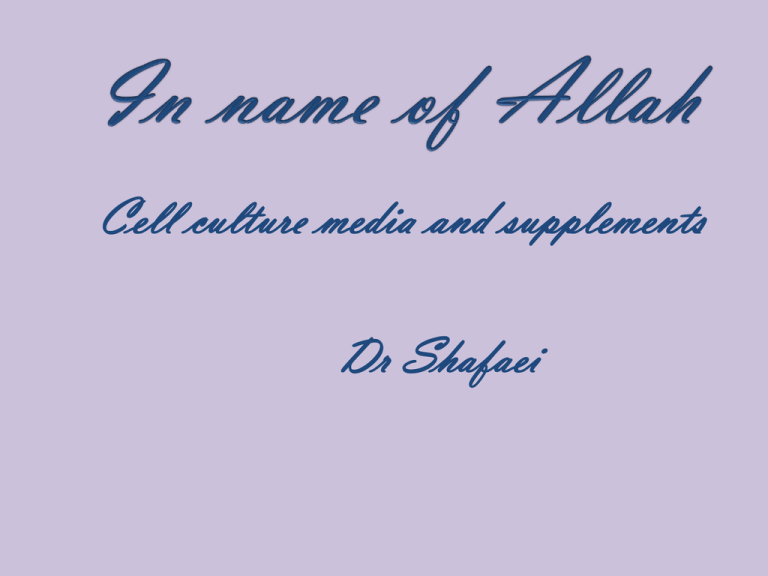
Cell culture media and supplements Dr Shafaei Contd.. • 1916: Rous and Jones introduced proteolytic enzyme trypsin for the subculture of adherent cells. • 1923: Carrel and Baker developed 'Carrel' or T-flask as the first specifically designed cell culture vessel. They employed microscopic evaluation of cells in culture. • 1925:subculthre of firbroblastic cell line. Contd.. • 1940s: The use of the antibiotics penicillin and streptomycin in culture medium decreased the problem of contamination in cell culture. • 1955: Eagle studied the nutrient requirements of selected cells in culture and established the first widely used chemically defined medium (DMEM). • 1961: Hayflick and Moorhead isolated human fibroblasts (WI-38) and showed that they have a finite lifespan in culture. • 1965: Ham introduced the first serum-free medium which was able to support the growth of some cells (Hams). • • • • • • • Contd.. 1975: Kohler and Milstein produced the first hybridoma capable of secreting a monoclonal antibody. 1982: Human insulin became the first recombinant protein to be licensed as a therapeutic agent. 1985: Human growth hormone produced from recombinant bacteria was accepted for therapeutic use. 1986: Lymphoblastoid γIFN licensed. 1987: Tissue-type plasminogen activator (tPA) from recombinant animal cells became commercially available. 1989: Recombinant erythropoietin in trial. 1990: Recombinant products in clinical trial (HBsAG, factor VIII, HIVgp120, CD4, GM-CSF, EGF, mAbs, IL-2). Adult stem cells: A brief history • Adult stem cell research began about 40 years ago • Bone marrow stromal cell discoveries in 1960s • Adipose derived stem cells are isolated in 2001. For Cross contamination elimination Stem cell niches Niche: Microenvironment around stem cells that provides support and signals regulating selfrenewal and differentiation Direct contact Soluble factors stem cell niche Intermediate cell Major development’s in cell culture technology • First development was the use of antibiotics which inhibits the growth of contaminants. • Second was the use of trypsin to remove adherent cells to subculture further from the culture vessel • Third was the use of chemically defined culture medium. A growth medium or culture medium is a liquid or gel designed to support the growth of cells Types of Cell Culture Media Media Type Examples Biological Fluids plasma, serum, lymph, human placental cord serum, amniotic fluid Tissue Extracts Extract of liver, spleen, tumors, leucocytes and bone marrow, extract of bovine embryo and chick embryo Clots coagulants or plasma clots Natural media Balanced salt solutions PBS, DPBS, HBSS, EBSS Artificial media Basal media MEM DMEM Complex media RPMI-1640, IMDM Natural Media • Very useful • Lack of knowledge of the exact composition of these natural media Artificial Media • • • • Serum containing media Serum-free media (defined culture media) Chemically defined media Protein-free media Basic Components of Culture Media • Culture media (as a powder or as a liquid) contains: – amino acids – Glucose – Salts – Vitamins – Other nutrients The requirements for these components vary among cell lines, and these differences are partly responsible for the extensive number of medium formulations . • • • • • • • Natural buffering system HEPES Phenol red as a pH indicator (yellow or purple) Inorganic salt Amino Acids (L-glutamine) Carbohydrates Proteins and Peptides (important in serum-free media. Serum is a rich source of proteins and includes albumin, transferrin, aprotinin, fetuin, and fibronectin • Fatty Acids and Lipids • Vitamins • Trace Elements Common Cell Culture Media • Eagle’s Minimum Essential Medium (EMEM) • Dulbecco’s Modified Eagle’s Medium (DMEM) – Low glucose – High glucose • • • • RPMI-1640 Ham’s Nutrient Mixtures DMEM/F12 Iscove’s Modified Dulbecco’s Medium (IMDM) Criteria for Selecting Media Cell Line Morphology Species HeLa B Epithelial HL60 Lymphoblast Human 3T3 clone A31 Fibroblast COS-7 CHO Fibroblast Epithelial Human Medium MEM+ 2mM Glutamine+ 10% FBS + 1% Non Essential Amino Acids (NEAA) RPMI 1640 + 2mM Glutamine + 1020% FBS Applications Tumourigenicity and virus studies Differentiation studies Mouse DMEM + 2mM Glutamine +5% New Tumourigenicity Born Calf Serum (NBCS) + 5% FBS and virus studies Monkey Gene expression and virus DMEM+ 2mM Glutamine + 10% FBS replication studies Hamster Nutritional and Ham′s F12 + 2mM Glutamine + 10% gene expression FBS studies EMEM (EBSS) + 2mM Glutamine + 1% Non Essential Amino Acids (NEAA) + 10% FBS Transformation studies F-12 K + 10% FBS + 100 µg/ml Heparin RPMI-1640 + 10% FBS Angiogenesis studies Signaling studies HEK 293 Epithelial Human HUVEC Endothelial Human Jurkat Lymphoblast Human Common media and their applications Media IMDM MEM DMEM RPMI-1640 Tissue or cell line Bone marrow, hematopoietic progenitor cells, human lymphoblastoid leukemia cell lines Chick embryofibroblast, CHO cells, embryonic nerve cells, alveolar type cells, endothelium, epidermis, fibroblast, glia, glioma, human tumors, melanoma Mesenchymal stem cell, chondrocyte, fibroblast, Endothelium, fetal alveolar epithelial type II cells, cervix epithelium, gastrointestinal cells, mouse neuroblastoma, porcine cells from thyroid glands, ovarian carcinoma cell lines, skeleton muscle cells, sertoli cells, Syrian hamster fibroblast T cells and thymocytes, hematopoietic stem cells, human tumors, human myeloid leukemia cell lines, human lymphoblastoid leukemia cell lines, mouse myeloma, mouse leukemia, mouse erythroleukemia, mouse hybridoma, rat liver cells Nutrient mixture Chick embryo pigmented retina, bone, cartilage, adipose tissue, F-10 and F-12 embryonic lung cells, skeletal muscle cells Media Supplements • Serum in Media – – – – – – – Basic nutrients Growth factors and hormones Binding proteins Promote attachment of cells to the substrate Protease inhibitors Provides minerals, like Na+, K+, Zn2+, Fe2+, etc Protects cells from mechanical damages during agitation of suspension cultures – Acts a buffer • Antibiotics • • • • • • • • • • • Aseptic conditions Switch on the laminar flow cabinet 20 mts prior to start working Swab all bottle tops & necks with 70% ethanol If working on the bench use a Bunsen flame Flame all bottle necks & pipette by passing very quickly through the hottest part of the flame Avoiding placing caps & pipettes down on the bench; practice holding bottle tops with the little finger Work either left to right or vice versa, so that all material goes to one side, once finished Clean up spills immediately & always leave the work place neat & tidy Never use the same media bottle for different cell lines. If caps are dropped or bottles touched unconditionally touched, replace them with new ones Necks of glass bottles prefer heat at least for 60 secs at a temperature of 200 C Never use stock of materials during handling of cells. Contaminant’s of cell culture Cell culture contaminants of two types • Chemical-difficult to detect caused by endotoxins, plasticizers, metal ions or traces of disinfectants that are invisible • Biological-cause visible effects on the culture they are mycoplasma, yeast, bacteria or fungus or also from cross-contamination of cells from other cell lines Effects of Biological Contamination’s • They competes for nutrients with host cells • Secreted acidic or alkaline by-products ceases the growth of the host cells • Degraded arginine & purine inhibits the synthesis of histone and nucleic acid • They also produces H2O2 which is directly toxic to cells Detection of contaminants • In general: turbid culture media, change in growth rates, abnormally high pH, poor attachment, multi-nucleated cells, graining cellular appearance, vacuolization, inclusion bodies and cell lysis • Yeast, bacteria & fungi usually shows visible effect on the culture (changes in medium turbidity or pH) • Mycoplasma detected by direct DNA staining with intercalating fluorescent substances e.g. Hoechst 33258 • Mycoplasma also detected by enzyme immunoassay by specific antisera or monoclonal abs or by PCR amplification of mycoplasmal RNA • The best and the oldest way to eliminate contamination is to discard the infected cell lines directly 33

